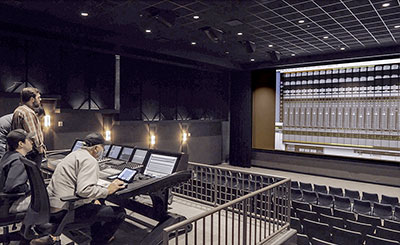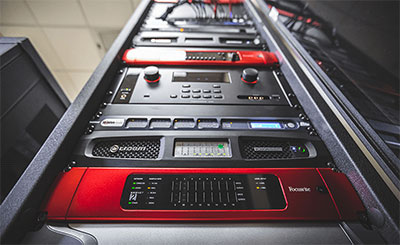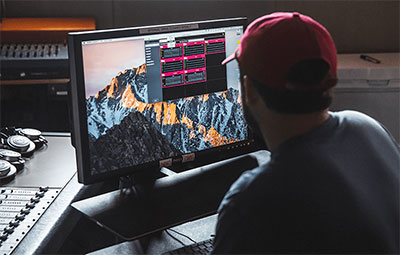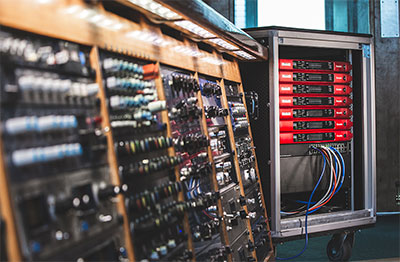![]() With courses covering music business, songwriting, audio engineering, motion pictures and media studies, the Mike Curb College of Entertainment and Music Business is the largest college on the expansive campus of Nashville’s Belmont University, and counts an average of 400 student majors each year from its audio engineering programme.
With courses covering music business, songwriting, audio engineering, motion pictures and media studies, the Mike Curb College of Entertainment and Music Business is the largest college on the expansive campus of Nashville’s Belmont University, and counts an average of 400 student majors each year from its audio engineering programme.
Key to its operation is the use of Focusrite’s RedNet and a Dante A/V network.
The school began life in the 1970s as a small department in the college of business, and has grown to offer performance spaces and production facilities, including green-screen rooms, TV studios, an anechoic chamber, a Foley/ADR suite and several music recording studios, plus a flagship 250-seat Dolby Atmos theatre. All of these are interconnected to offer the greatest possible audio management. Many of these facilities are in the Johnson Center, which opened in 2015. The newness of the building plays a large part in Belmont’s present day technical capabilities – audio networks were integrated into the architectural plans for the building, such that audio is as central to the design of the building as any other utility.
 ‘We were running out of space,’ recalls Michael Janas, Chair of the Audio Engineering Technology department at Belmont. ‘We were juggling a lot of stuff around, and we had to expand.’
‘We were running out of space,’ recalls Michael Janas, Chair of the Audio Engineering Technology department at Belmont. ‘We were juggling a lot of stuff around, and we had to expand.’
When approval for the new building was granted, he approached the Curb College faculty with a proposition: ‘What do you want out of this building?’.
The response was to equip the facility with a next-generation audio-over-IP infrastructure that could be expanded without the requirement to retrofit equipment. ‘We were right in the middle of trying to figure out what we wanted, and then we started hearing about RedNet equipment and the Dante network,’ Janas says.
A wishlist of equipment and a plan to implement it followed. At this point, they brought in Ron Romano – an experienced network engineer and former owner of an A/V integration company; now Technology Specialist at the College – to lead the roll-out. In addition to overseeing the audio infrastructure and other A/V systems, he manages several hundred computers and other IT systems.
‘We wanted to make sure that we had a facility that had a lot of great-sounding gear in the individual rooms, but also the ability to interconnect rooms and move audio around the facility,’ Romano says. ‘From there, we started drawing a line diagram of what we were looking to put together.’
He admits to having no specific experience with Dante when he came to the school – at that time is was still a fairly new technology: ‘My first experience with RedNet and the Dante network was really that eye-opener that any tech would have. You’ve read about it, you’ve seen the videos; it almost sounds too good to be true until you fire it up.’
The Dante network’s trouble-free se-tup process enabled Romano to quickly bring rooms online, even when the construction team were still working. ‘We asked the contractors to give us the keys to a room that was complete, and this became our temporary staging area for all the systems.’
From their staging post, Romano and his team configured, tested and troubleshot the equipment racks and prepared them for installation in their respective locations as soon as they were signed off by the building contractors. They were able to set up the whole campus-wide system in one room, test it all working together, then deploy it across the building as soon as they got the opportunity. Dante Controller – the application that provides audio subscription control for all devices on the network – was critical to this phase, as was RedNet Control, free software for Mac and PC that lets you control all the RedNet devices throughout the network from anywhere else on the network.
In a short space of time, with the new academic year fast approaching, Romano and his team of student workers brought the Johnson Center online and made it fully operational. There are a total of six facilities that have Dante equipment permanently installed, and they all have the ability to patch room-to-room, or all rooms together. The flagship Dolby Atmos theatre has a pair of Mac Pro computers with two RedNet 5 Pro Tools HD Bridges, providing 32 channels of I/O on each side of the console.
‘RedNet 6s provide the Madi connection for the console, and out to the Dolby RMU, which is the box that does all the Dolby Atmos magic,’ Romano explains. ‘We have a smaller 7.1 mix room, which is a similar set-up to the large theatre minus the Atmos capabilities. In another rack room adjacent to the Foley/ADR suite, we have a set of RedNet 4 microphone preamps that students remotely control using RedNet Control. We’ve actually integrated the RedNet Control into the Pro Tools channel strip – it’s nice for a student to be in Pro Tools and actually control the preamps right inside the Mix window.’
Alongside these permanent RedNet installations, the whole building is wired for Dante, so any space can be activated. Two rolling racks containing RedNet 2 ADDA converters are on-hand to provide up to 80 channels of I/O to any corner of the campus with a network port. Accoring to Romano, one of the best facets of the new system is that ‘it makes us look good’.
‘It seems like, every time we put the [RedNet] stuff into a project, it just hits it out the park, everybody’s happy, the project looks great, everything sounds good. That’s what it’s all about. We just want to solve problems and get it done. Now that we’ve moved into an audio-over-IP system with the Dante network and the RedNet gear, the possibilities are endless, and we just continue to be blown away with its capabilities.’
 Since the Dante network and RedNet infrastructure were installed, the equipment has been used for many applications. Once a year, the school hosts a major concert, entitled Best Of The Best, showcasing some of the best talents selected from four prior showcase concerts throughout the academic year. At the 2019 showcase, hosted in the Curb Event Center, the Dante network and the RedNet equipment enabled previously impossible capabilities, which the Audio Technology Department took advantage of. Audio from the FOH console was sent via Madi into a RedNet 6, and then over the Dante network via fibre-optics across campus to the Johnson Center. The Dante audio was accompanied by a programme video feed from the arena, and simultaneously a live feed was sent to the Johnson Center TV studio, and to the 7.1 mix studio where a live recording session – in sonically isolated conditions – was conducted.
Since the Dante network and RedNet infrastructure were installed, the equipment has been used for many applications. Once a year, the school hosts a major concert, entitled Best Of The Best, showcasing some of the best talents selected from four prior showcase concerts throughout the academic year. At the 2019 showcase, hosted in the Curb Event Center, the Dante network and the RedNet equipment enabled previously impossible capabilities, which the Audio Technology Department took advantage of. Audio from the FOH console was sent via Madi into a RedNet 6, and then over the Dante network via fibre-optics across campus to the Johnson Center. The Dante audio was accompanied by a programme video feed from the arena, and simultaneously a live feed was sent to the Johnson Center TV studio, and to the 7.1 mix studio where a live recording session – in sonically isolated conditions – was conducted.
‘I don’t think we’d be able to do some of the things that we do if we didn’t have the Dante network and the RedNet equipment,’ Romano reflects. ‘Sure, there are always long ways to go analogue, but once you experience audio-over-IP and start to use it, you realise that this is the Swiss army knife you’ve been looking for.’
Of the student experience, Romano quotes the breadth of systems the learners are exposed to during their time at Belmont: ‘I think it’s important that a student gets their hands on a little bit of everything as they go through the programme. Now they can say ‘I know how to do Audio-over-IP, and I’ve used Dante Controller and RedNet Control.’ That’s a huge benefit before they get out in the real world.’
The Ocean Way Connection
It’s now common for education establishments, particularly in the US, to have professional-level facilities that rival and sometimes exceed those of commercial operations. The intent is obvious: to provide the best possible learning experience so that students are prepared for whatever industry throws their way. Exploiting this and their shared location, Belmont University and Ocean Way Nashville – a short stroll from the university campus, at the heart of Music Row – have jointly enabled students and staff to travel freely between the sometimes disconnected worlds of education and commercial production.
 Students on Belmont’s Audio Engineering Technology programme are allocated time in the Ocean Way Nashville recording facilities – just as they might book a session in other facilities on campus. The difference is that Ocean Way Nashville is the birthplace of countless classic albums, hundreds of movie soundtracks, and a huge number of video game scores.
Students on Belmont’s Audio Engineering Technology programme are allocated time in the Ocean Way Nashville recording facilities – just as they might book a session in other facilities on campus. The difference is that Ocean Way Nashville is the birthplace of countless classic albums, hundreds of movie soundtracks, and a huge number of video game scores.
While the benefits of this arrangement are plentiful, Director of Studio Operations Pat McMakin has found himself responsible for addressing the accompanying challenges. As a veteran of Music Row, he has a progressive and collaborative approach to getting things done, working smarter not harder to achieve his objectives.
One such was to cater for the needs of a client with very specific technical requests: ‘We had a mixer come to town that wanted to be able to mix a film in 5.1 in Studio B, recalls Ron Romano, Technology Specialist at the Curb College of Entertainment and Music Business, whose remit also includes Ocean Way Nashville, recalls
The challenge appears simple on the surface, but in practice it has several facets. First, Studio B is configured as a stereo room, so transforming it into a 5.1 surround environment was the first order of business for the team but the console also needed to be live as a fader-and-mute group for physical mixing.
The Neve VRP96 in question is described by Ocean Way as ‘hot-rodded’ with limiting and compression on each of the 96 input channels and ‘every possible option and sonic upgrade’. The solution meant duplicating I/O capabilities and providing enough connections so that a Pro Tools HD recorder could capture the discrete channels independently of the console.
A third aspect to the scenario was that the mix would not be completed in one block. (It’s common for film projects to book a room for several weeks to complete a mix from start to finish.) In this instance, the production team would come in for a day or two here and there, so the stereo-to-surround conversion would have to be repeated several times, and would need to be done speedily in order to minimise downtime.
‘With Ocean Way Nashville being a commercial facility that’s constantly busy with cutting records and film scores, we just don’t have time to be down for very long,’ Romano says. ‘Among the ideas was that RedNet was going to solve this problem.’
 Romano’s track record with using Audio-over-IP as a problem-solver is evident in the campus-wide Dante system implemented at Belmont’s other studios and facilities. For the Studio B system, Romano put together a rolling rack comprising RedNet HD32R Pro Tools HD Bridges to interface between Dante and the playback and record Pro Tools environments. RedNet A16R analogue I/Os were used to make the line-level connections with the studio infrastructure, via EDAC multi-pin connectors, making the console an extension of the network.
Romano’s track record with using Audio-over-IP as a problem-solver is evident in the campus-wide Dante system implemented at Belmont’s other studios and facilities. For the Studio B system, Romano put together a rolling rack comprising RedNet HD32R Pro Tools HD Bridges to interface between Dante and the playback and record Pro Tools environments. RedNet A16R analogue I/Os were used to make the line-level connections with the studio infrastructure, via EDAC multi-pin connectors, making the console an extension of the network.
‘The RedNet equipment gave us all the inputs and outputs and D-D that we needed to make that project work,’ McMakin summarises. ‘Everything ported the way it was supposed to, and everything sounded the way we wanted it to sound. Having the RedNet gear with Audio-over-IP, it’s just Ethernet connections, plug-and-play, and the units remember the patching.’
With the project complete and the proof of concept tested, RedNet at Ocean Way Nashville will not be a one-hit-wonder. In a gradual adoption of Dante site-wide, the studio uses several AM2 units around the site, and the team have discussed connecting the studio to the already Dante-enabled Belmont University campus via a fibre-optic link. The goal would be to access audio anywhere on the Belmont site, so the University’s arena concerts could be recorded and mixed live in Ocean Way’s studios, for example, and students could experience recording a pro orchestra using audio subscriptions from Ocean Way’s stunning Studio A live room. In conclusion, the road is long for RedNet in Nashville, and Belmont University already have an impressive head start.
Unsurprisingly, Belmont’s audio system is growing. At the time of writing, Belmont was in the planning stage for another new building, set for completion in 2020. Dante and the new line of RedNet interfaces will play a large role in the audio infrastructure, and a fibre-optic connection between the Johnson Center and the new building will physically expand the system and interlink the buildings.